Menu
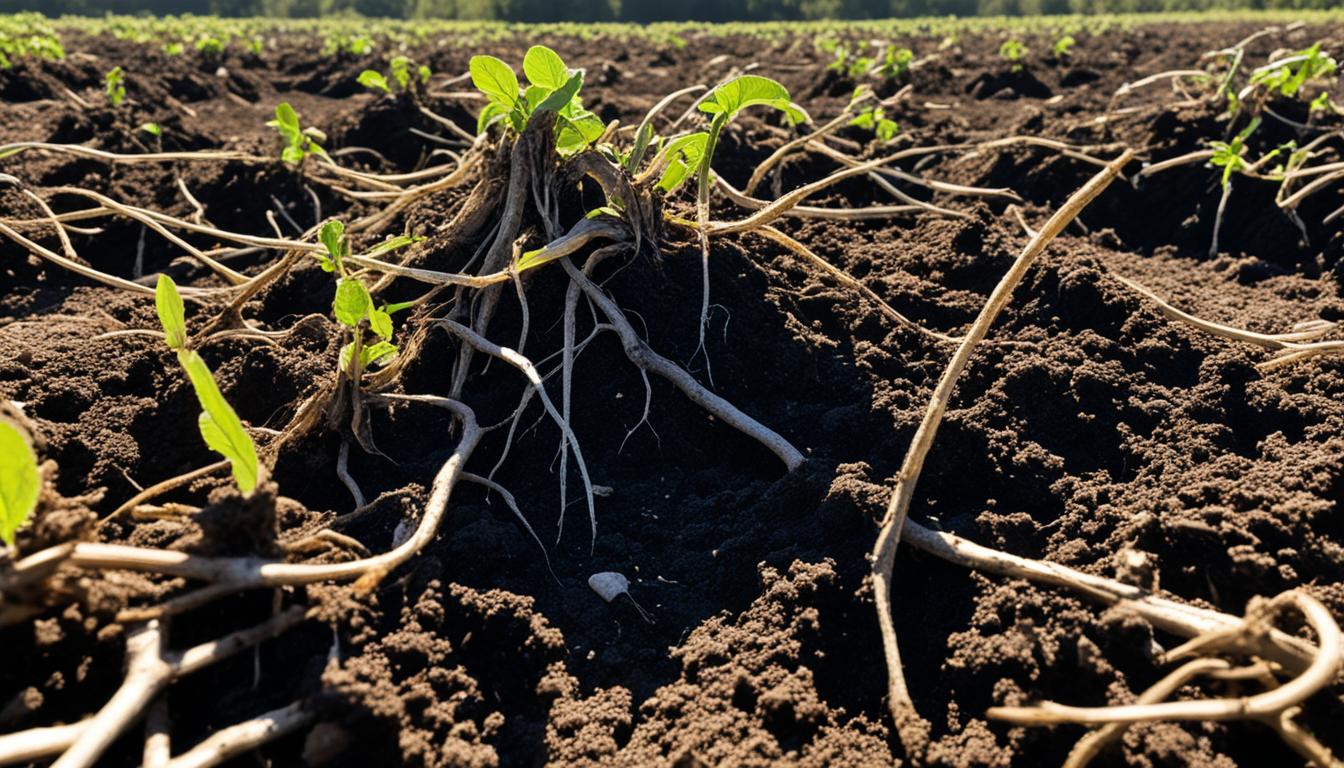
Did you know legume cover crops can raise soil organic matter from 8% to 114%? Meanwhile, non-legume cover crops, like grasses, can increase it by 4% to 62%. This shows how important cover crops are for keeping soil healthy and farm practices sustainable.
Soil organic matter is crucial for soil health. It acts like a sponge, holding water and nutrients. This improves the soil’s ability to recover and manage nutrients, reducing water pollution. With 58% carbon content, it also brings financial benefits. Improving soil organic matter could save up to $25 billion each year through better soil carbon management.
Good cover crop management includes practices that don’t disturb the soil. This can help the environment a lot, improving water quality and soil health. By adding manure, leftover plant parts, or specially grown crops to the soil, we can boost its organic matter. This leads to better and more productive farms.
Soil organic matter is key for healthy soils. It includes living organisms, dead plant parts, and stable matter like humus. This mix affects soil texture, making it better for growing crops. Most agricultural soils have 1–6% organic matter. This diversity helps soils stay healthy and strong.
A surprising fact is that 25% of the world’s biodiversity lives in soil. This shows how important soil organic matter is for life and farming. It feeds tiny creatures in the soil. These little helpers break down materials, turning them into plant food.
About 70% of soil organic matter is well-decomposed humus, the ‘very dead’ kind. Humus is vital for healthy soil. About 15% is living and interacts with tiny soil life. This helps plants get the nutrients they need and improves the soil’s build.
The breakdown of soil organic matter is affected by the environment. Things like soil pH and temperature matter a lot. Soil works best for bacteria between 70 and 100ºF. Low pH slows down the breakdown, affecting plant nutrients. Adding things like compost keeps the balance. So does changing the crops you grow and how you work the land.
Having about 3.75% organic matter makes soil great for growing crops. The Amazon’s soil is unique. It has lots of black carbon from old farming methods. This black carbon does a lot. It helps keep the environment stable, lets soil hold onto nutrients, and encourages soil life.
Many elements make up soil organic matter. It includes living organisms in the soil, decomposed plant and animal parts, and humus. The active part of this matter changes a lot, affecting how nutrients move and the soil’s makeup.
Humus isn’t just any part; it’s the stable form of soil organic matter. It makes water move better, improves air in the soil, and helps with nutrient exchange. By supporting tiny living things in the soil, it makes the ground healthier. The best soils for growing plants have 3% to 6% organic matter. This shows keeping humus high is very important.
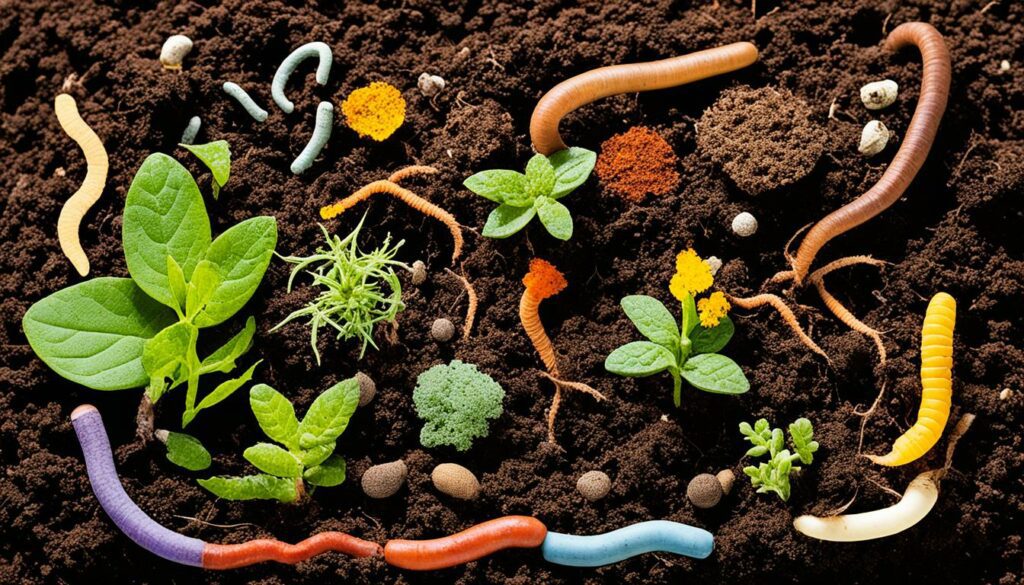
Certain microorganisms are key to creating and keeping humus. They break down dead things into nutrients that plants can use. This not only adds to the soil’s nutrient bank but also makes it hold onto water better. The type of soil microbes, how hot and wet the soil is, all play a part in making stable organic matter.
We can add various things to boost the soil’s organic matter. Things like leftover parts of plants, animal waste, compost, and special plants can help. Not ploughing the soil too much also helps. It stops the ground from losing its organic matter too quickly.
Checking the amount of soil organic matter regularly is important. Tests like soil sampling and the loss-on-ignition (LOI) test are useful. They tell us if our farming ways are working. Good soil organic matter management boosts the land’s ability to grow crops. This means better farm profits.
| Organic Material Source | Contribution to Soil Organic Matter | Benefits |
|---|---|---|
| Crop Residues | Rich in active fraction | Promotes nutrient cycling and soil structure |
| Animal Manure | High in microbial biomass | Increases microbial biodiversity and nutrient availability |
| Compost | Stable form (humus) | Improves water holding capacity and soil aeration |
| Cover Crops | Green manure contributes to active fraction | Reduces erosion, enhances soil structure |
| Perennial Grasses and Legumes | Enriches soil organic matter over time | Enhances nutrient availability and CEC |
Soil organic carbon is key for the planet’s carbon cycle. It’s a vital part of soil’s life and acts like a foundation. This element supports the soil’s structure and keeps it productive and stable.
Organic carbon in soil does a lot. It makes the soil hold onto important nutrients for plants. This helps make the soil stronger, letting air and water flow better. As a result, the soil can produce more and stay in good shape. It fights off problems like soil washing away or nutrients moving deep down.
Many things add to the amount of organic carbon in soil. Green manures, cover crops, and leftovers from crops are some. Also, using compost and manure helps a lot. When used smartly, these things can make soil healthier. They make an agricultural system that’s stronger and doesn’t easily break down. Plus, methods like planting different crops in turns help keep the carbon cycle stable and make nutrients work better.
Humus is the result of organic matter breaking down. It comes from plant and animal leftovers. This natural process is key for keeping soil healthy, improving its structure, and letting water soak in. The presence of humus also leads to soil that’s crumbly, a must for good agriculture.
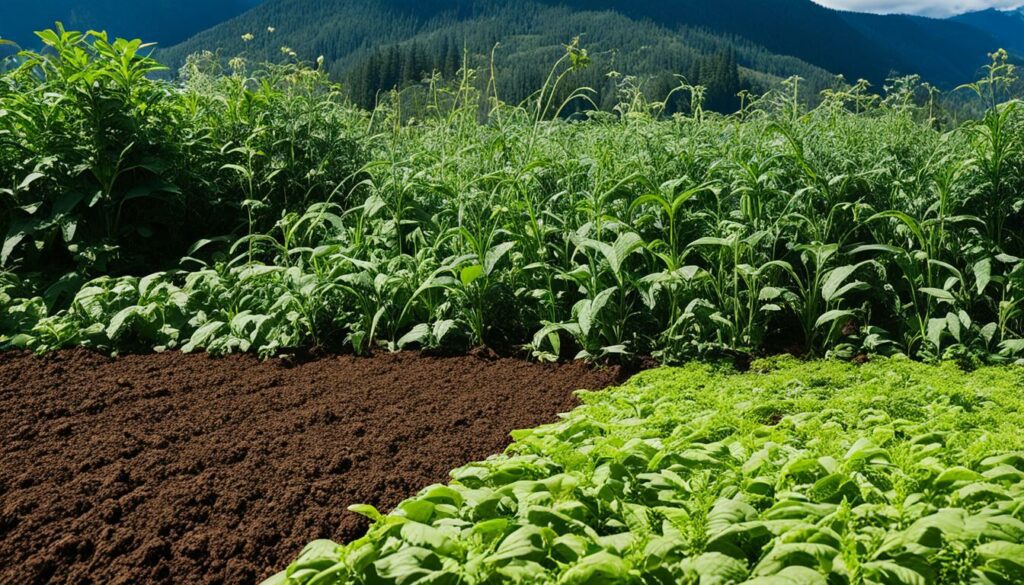
Over time, organic bits like dead plants and animals turn into humus in the soil. Microbes play a big part in this, breaking down the leftovers. This breakdown helps release important nutrients like nitrogen into the soil. For example, 1% of organic material in the top soil can release up to 20 lbs. of nitrogen, and more. This process helps the soil become more fertile.
Humus is vital for soil health in several ways. For starters, it boosts the soil’s structure. This makes soil particles stick together. It helps soil absorb and keep water better. This means the soil is less likely to wash away and can withstand dry spells better.
It also makes the soil easier to manage and helps roots grow well. The best soils for crops have around 3-3.5% organic stuff in them. And, when a soil has about 3.75% organic matter, it usually gives the best harvests. Just adding 1% organic matter can make the soil less dense and hold more water.
By having the right amount of humus, the soil holds on to the nutrients plants need. The perfect balance is from 3-6% humus. With the right nutrition, plants can thrive, making farming more sustainable.
| Benefit | Impact on Soil |
|---|---|
| Improved Soil Structure | Increases water infiltration and retention, reducing erosion |
| Enhanced Soil Friability | Easier to work with, facilitates root growth |
| Increased Nutrient Release | Releases essential nutrients like nitrogen, phosphorus, and sulfur annually |
| Reduced Bulk Density | Increases available water capacity, leading to better drought resilience |
Grasping the link between nutrient cycling and soil health is key for better crops. Soil’s active part helps release nutrients, making them ready for plants.
Nutrients stored in organic matter break down, thanks to life processes, making them available. Just 1% more organic matter per acre in the top soil means 1,000 pounds of nitrogen, 230 pounds of phosphorus, and 165 pounds of sulfur. These nutrients are crucial for healthy crops.
Warm weather speeds up the process, getting more nutrients to plants when they need them most.
Good nutrient cycling helps soil stay healthy and boosts crop growth. It’s important to disturb the soil less to help these cycles. This lets helpful soil life, like free-living and root-symbiotic beings that fix nitrogen, do their job.
Nutrient cycling helps crops needing special minerals, like legumes needing molybdenum. It ensures crops get all they need to grow strong, linking soil health to better crops.
Soil’s organic part also boosts its ability to hold and share nutrients. More organic matter means better nutrient access for plants. Plus, managing soil’s pH helps make sure crops get important minerals. For example, blueberries like low pH for more iron, but earthworms and bacteria like neutral pH.
| Soil Function | Importance to Nutrient Cycling | Impact on Crop Productivity |
|---|---|---|
| Nutrient Release | Ensures essential nutrients become available to plants. | Increases crop yields and quality. |
| Organic Forms of Nutrients | Stores nutrients like nitrogen, phosphorus, and sulfur. | Supports sustained plant growth and health. |
| Plant Available Nutrients | Maintains soil fertility and nutrient cycles. | Enhances agricultural productivity. |
| Sustainable Cropping Systems | Reduces soil disturbance and fosters beneficial organisms. | Promotes consistent and sustainable crop yields. |
In the end, the nutrient cycle shaped by organic matter is the bedrock of sustainable farming. It keeps the soil rich and resilient. This leads to more and better crops over time.
Carbon sequestration is key in keeping our environment healthy. It’s the process where carbon is taken from the air and stored in the soil. A large part of this process happens because of agricultural work. When farmers improve their soil by adding more organic matter, they help store carbon. This helps fight climate change by reducing harmful greenhouse gases.
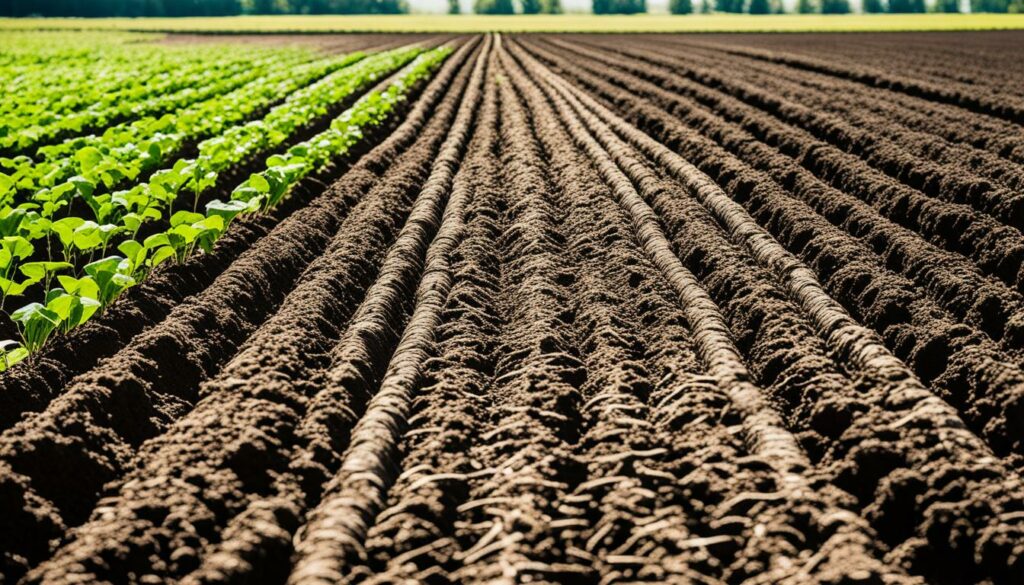
Carbon sequestration means taking carbon dioxide out of the air during photosynthesis. Then, this captured carbon is stored in plants and soil. Soil is crucial; it holds 80% of the terrestrial carbon. This is much more than what the air can hold. Techniques like no-till farming and adding crop residues back to the soil increase carbon storage. So do using organic materials.
Carbon sequestration helps in many ways. It lowers the amount of CO2 in the air, a gas that has increased since before we started using a lot of machines. Our actions, particularly burning fuels, are the main cause of these increases. This process also makes soil better. It can hold more water, which is good for plants, and it supports a range of life, increasing Biodiversity.
The soil can store a lot of carbon, more than three times what the air can hold. Since soil can take in carbon faster than the oceans, it plays a big part in keeping our planet healthy. Each year, around 3 gigatons of carbon are stored in the soil. This is more than what the oceans can do.
Studies have also shown that farming without synthetic fertilizers and not much use of chemicals helps the soil store more carbon. They compared farms that used more natural methods to those that used a lot of chemicals. The natural farms increased their soil carbon every year by 2.2%. This shows how helping the environment through farming is possible and effective.
Decaying matter in the soil is crucial and quite complex. It’s all part of nature. Tiny creatures like bacteria and fungi break down dead plants and animals. They release stuff that makes soil stronger and better at holding water.
The breakdown of soil matter keeps the ground healthy. Remarkably, there are over 20,000 different soil types in the US alone. Each one has its own story to tell. It’s like a big puzzle with many pieces.
The way stuff breaks down changes the soil’s make-up. It can make the soil lighter or heavier. Think of it like this, soil can be like mushy clay or quick-draining sand. This impacts how water flows through the ground.
Soil full of clay holds water tight. This can make it hard for plants to drink up. Wet soil can block oxygen and make it hard for plants to breathe. But, when soil has air pockets, it’s a happy place for roots.
A lot of tiny life forms help decompose dead stuff in the soil. Some like it cooler, but others work in the heat. As they eat away at organic matter, they make the soil warmer. In fact, places where they do this can get really hot!
When soil gets hot quickly, it can kill bad germs and weed seeds. Plus, these little workers also help soil clump together. This makes the ground better at keeping water and letting plants grow well. So, what they do is vital for a healthy soil and everything that lives in it.
| Soil System | Number of Classes |
|---|---|
| FAO | 26 |
| Canada | (Own Classification) |
| United States | 20,000+ Soil Series |
Microbial activity is key to soil health, impacting nutrient cycling and soil stability. Human activities lead to the loss of 24 billion tons of soil yearly. So, boosting microbial life is very important. Let’s look at ways to increase microbial activity in the soil.

Many things affect how active microbes are in the soil. This includes:
We can use a few methods to lift microbial life in the soil. This helps in creating a healthy environment. Here are some ways:
Today, we know how to restore land with technology and focus on soil microbes. This approach helps create homes for many species. It shows that combining new and old ways of farming increases farm production and protects nature. By 2050, using these methods could make agriculture 2% more productive globally and cut biodiversity loss by 11%. This strategy not only fights soil damage but also helps in reaching sustainable farming goals.
Cover crops are essential in farming for many reasons. They help the soil stay healthy, stop erosion, and make water cleaner. There are different kinds of cover crops, such as grains, brassicas, and legumes. These are chosen based on when they grow and what they help with.
Cover crops are grown to stop soil from washing away, make the soil better, look after nutrients, and clean water. They can be winter or summer plants. Winter types include rye, while summer ones like clover and oilseed radish are common.
Using cover crops greatly improves the condition of the soil and how farms work. They handle nutrients well, stop erosion, and clean water. This makes farmland more efficient and lasting longer.
| Type | Increase in SOM Levels | Additional Benefits |
|---|---|---|
| Legume Cover Crops | 8% to 114% | Fix nitrogen, reduce soil compaction, improve nutrient management |
| Non-Legume Cover Crops | 4% to 62% | Enhance soil structure, provide erosion control, improve water quality |
Cover crops help improve how soil holds water and its structure. They increase the organic matter in soil, improving water absorption and helping the soil bugs work better. This also means the soil is safer when there’s lots of rain or it’s very dry.
Cover crops have been used for a long time, even over 3,000 years ago. Recent studies, like ones in 2019–2020, show cover crops help today too. Farmers grow better crops using less chemicals, which is good for the world and their wallets.
Reduced tillage is key for farming that’s sustainable. It keeps the soil disturbance to a minimum, helping to protect and conserve the soil. By doing so, it helps maintain the health and productivity of the soil over time.
Reduced tillage is a way of farming that disturbs the soil less. It includes methods like no-tillage, strip-tillage, and ridge-tillage. These are different from conventional tillage, which involves deep ploughing that can be harmful to the soil.
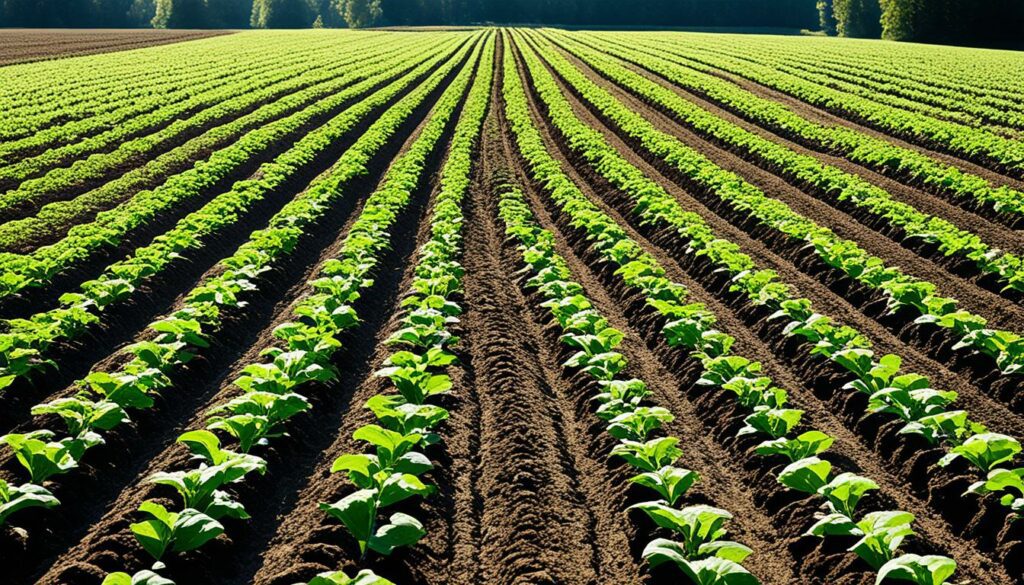
Conservation tillage boosts the amount of organic matter in the soil. It does this by slowing down how quickly organic matter breaks down. This is great for soil health and its ability to support plant life.
No-tillage, for example, can add about 1 ton of organic matter per acre each year. It also helps reduce the amount of carbon dioxide that the soil releases into the air. This compares well to moldboard ploughing methods that cause more carbon loss in a short time.
Using cover crops that produce a lot of plant material is also important. These crops add to the organic matter in the soil. When this is combined with good crop nutrition and regular soil checks, it helps the soil stay healthy over the long term. This means farmers can grow more crops without harming the land we rely on.
Looking at different tillage methods, the next table shows how they compare:
| Tillage Practice | Soil Organic Matter (0-15 cm) | Soil Carbon Loss First Hour (lbs C/acre) | Soil Carbon Loss First Three Weeks (lbs C/acre) |
|---|---|---|---|
| Conventional Tillage | Low | 1.9 | 125 |
| No-Tillage | High | 0.60 | 73 |
| Strip-Tillage | Moderate | Varies | Varies |
| Ridge-Tillage | Moderate to High | Varies | Varies |
Moving to reduced tillage has big benefits. It makes soil stronger and more productive. This is good for the farm’s health and for growing crops. So, it’s important for farming well in a way that doesn’t hurt the environment or our pockets.
Crop residues are key in keeping agriculture sustainable. They protect the ground and improve the soil. By not removing them after the harvest, residues shield the earth from being eroded by wind and rain.
As these residues decay, they recycle nutrients. This helps the soil stay fertile and supports plant growth. They also stop plant diseases by fighting harmful germs and making substances that kill them.
Things like Holganix Bio 800+ Breakdown are great for breaking down residues. They’re full of different types of soil organisms. These products make the ground better for seeds, improve soil structure, and free up nutrients. Using them enhances the health of the earth we grow on.
When residues break down, they add stable carbon to the soil. This boosts fertility and the ability to hold water. Usually, farms have between 1 to 6% organic matter in their soil. The living part of this makes up about 15% of the whole.
We need to manage crop residues well, by keeping some and using some. This keeps the soil strong and supports farming. As we focus more on sustainable ways of farming, crop residues will play a big part in keeping our land healthy and productive.
Adding things like compost and manures to soil is a great way to improve it. These natural changes help boost soil’s ability to grow crops. It’s a key part of keeping the soil healthy for farming.
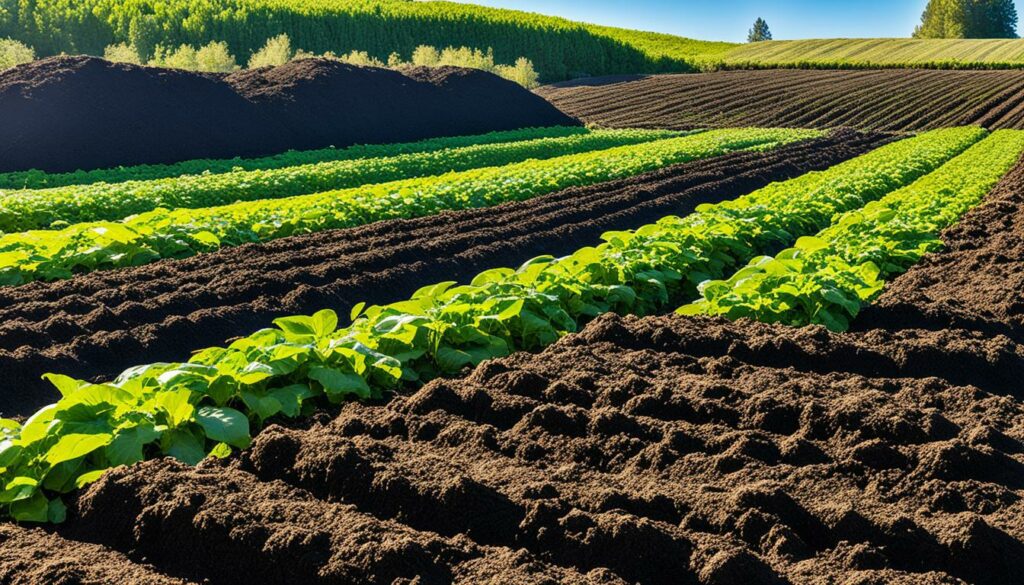
Compost comes from different materials, each with its own advantages. You can use things like leftover garden bits, food leftovers, and manure. For example, BLOOM and Milorganite give plants extra support. They contain 5-2-5 nutrients to help your plants grow. Adding compost improves soil structure and gives plants the nutrients they need.
One cubic foot of compost weighs about 40 lbs. But, a cubic yard can weigh 1,100 lbs because of the extra moisture. It’s key to spread compost right. Use about 8.33 cubic feet for every 100 square feet to a one-inch depth for best results.
Putting manure on soil needs to be done the right way. There are different types of manure, and each has its benefits and drawbacks. For example, fresh poultry manure is good for plants because it’s full of nitrogen. But, it can be too salty. Wait 3 to 4 weeks before planting to avoid harm. Horse manure, when fresh, may have weed seeds. It’s best not to use it for root crops because of disease risks.
Understanding the nutrients in manure is crucial. Most of the phosphorus and potassium in manure help plants in the first year. Manure that’s turned into compost is even richer in nutrients. Over a few years, the nitrogen it provides increases further. Composted dairy cow manure is needed at about 200 pounds per use for crops to benefit.
It’s very important to manage how much manure goes into the soil. Too much can cause problems, like too many nitrates. These can harm water and lead to too much plant growth. A good plan balances manure with soil checks and other ways to boost crop growth. This keeps the soil and plants healthy.
Keeping an eye on soil organic matter is key for farm health and productivity. Regular soil testing and analysis give us info on organic matter levels. This helps farmers improve their soil management practices with solid data.
Samples should be taken often, every 3-5 years, to see changes over time. This lets us make smart changes to how we manage the land. I like to test the soil in spring or autumn. The soil is easier to work with, and there’s lots of life in it then.
The type of soil affects how organic matter builds up. Soil with lots of clay keeps its organic matter better than sandy soil. Knowing this, I focus on putting in the right materials and using farming methods that suit the soil type.
| Interval | Focus |
|---|---|
| 0-5 years | Establish baseline levels of soil organic matter through thorough soil testing and analysis. |
| 5-10 years | Adjust soil management practices based on trends observed in organic matter levels. |
| 10+ years | Refine strategies and continue monitoring to ensure long-term soil health and productivity. |
There’s also the ‘light fraction organic matter’ that we need to watch closely. It gives us quick feedback on how our recent soil management is working. By always updating our data and using things like GPS, we keep our methods sharp and successful.
Working with others, like in the Soil Carbon Project, helps us improve soil testing. Projects like the one in Cornwall & the Isles of Scilly, which got £11.8m, offer more help. They bring us extra knowledge and tools to keep our soils healthy nationwide.
Farmers face various hurdles in keeping soil organic matter strong. These challenges include drought, managing water, and controlling erosion. By tackling these issues head-on, it’s possible to boost soil health and keep it in good shape for longer.
Keeping water in the soil is crucial, particularly when it’s dry. The topsoil (the upper 4-8 inches) holds most organic matter, plant roots, and tiny creatures. Sensitive care in the form of raised beds and compost helps fight soil hardening and keeps water where it’s needed. Testing soil for how well it drains and aiming for a 1-inch per hour soak rate is key. It ensures the land can weather dry spells and other challenges better.
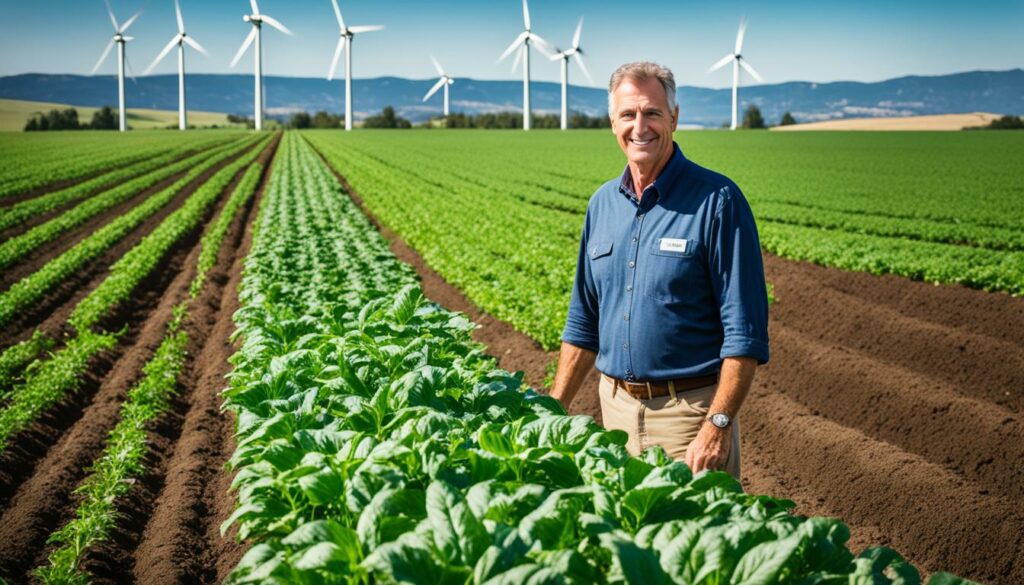
Protecting soil against erosion is vital for its health. Topsoil loss, often seen during construction, and the compaction of clay-rich soils reduce air spaces vital for plant roots. To safeguard against these issues, using cover crops and careful tillage help a lot. Such practices improve the soil’s structure and water-holding abilities while limiting erosion. It’s also important to regularly check the soil’s nutrients and pH to know how to feed it properly.
In addition, some soil types can become waterlogged, especially if compost is mixed in next to clay-like soil. This problem might discourage root growth. This highlights why it’s crucial to thoroughly check and fix soil issues before planting. Fixing soil after planting is often tough and expensive.
A recent study looked at the real-world impacts of improving soil health. It found that sustainable farming can bring big gains, both in money and for the environment. Four farms were looked at, and they made an average of 176% more money, ranging from 35% to 343%. Every farm saw their crops do better, with harvests improving by 2% to 22%, thanks to better soil health.
The research was a team effort with the USDA’s Natural Resources Conservation Service (NRCS). They checked out farms growing corn and soybeans in Illinois and Ohio, almonds in California, and mixed crops in New York. These farms showed they were cutting down on harmful stuff like nitrogen and phosphorus by a lot, and reducing soil from washing away. This was all tracked with a USDA tool.
One standout was HaR-Go Farms in New York, which started focusing on soil health in 2009. This organic dairy farm began using methods like not tilling the soil and adding cover crops. One result was they made $4,780 more each year from a 450-acre area. Changing to no-till for growing hay also cut down on hard work and made the soil keep more water, growing more crops. These changes even brought down the greenhouse gases they make by a lot on a small field.
These results show how much improving soil health matters. It helps farming be more profitable and protects the planet. When farmers use methods like planting cover crops, managing nutrients better, and being careful how they till the soil, it really boosts the soil’s health. This makes farming more sustainable, no matter what’s growing.
Soil organic matter is like a sponge in the soil. It stores water and nutrients. This makes the soil more fertile and strong. It’s vital for growing healthy crops.
Cover crops protect against erosion and provide homes for helpful microorganisms. Legumes can increase organic matter from 8% to 114%. Non-legumes can do this by 4% to 62%. This helps in managing soil nutrients well.
Soil organic matter is valuable because it’s mostly carbon. It can save up to billion every year. Carbon is key for soil health and reducing pollution in water.
It’s made up of living things, leftovers from crops, decaying plants, and a type of soil called humus.
Organic carbon makes up about 58% of soil organic matter. It helps with many important activities in the soil. This includes feeding tiny soil organisms and making nutrients easy for plants to use. It’s good for the soil’s health overall.
Humus makes soil better for plants. It helps the soil hold water and keeps its shape strong. This also encourages more life in the soil. All of this brings bigger and better crops.
Nutrient cycling uses soil organic matter to give plants important nutrients when they need them most. This helps crops grow well, even in tough conditions.
Carbon sequestration is about keeping carbon in the soil. It helps fight climate change by taking carbon dioxide out of the air. It also makes the soil better for plant life and animals.
Microbes do a lot of work in the soil. They help make soil hard so it doesn’t wash away. They also make nutrients ready for plants. Using less digging helps these tiny workers do more for the soil.
Cover crops are great at making soil healthy. They stop it from washing away, keep water clean, and help with nutrient use. They include different kinds of plants, like grains and beans. These make the soil a great place for all plants to grow.
Reduced tillage means not digging the soil up too much. This keeps the soil carbon-rich and holds water well. It’s good to stop the soil from eroding and keep it full of life.
Crop leftovers protect the soil from washing away. They also give the soil back important nutrients when mixed in. This helps keep the land good for growing food in a way that doesn’t harm it.
Things like compost and manure really help the soil. They bring lots of good nutrients that make the soil nice for plants. It’s important to use these in a way that’s good for the land over time.
To keep an eye on soil organic matter, do soil tests. This lets you know how much good stuff is in the soil. Knowing this helps you take care of the soil well.
To keep soil healthy, save water and stop the soil from getting too hard. Using cover crops, not tilling too much, and making ways to keep water are smart moves.
There are many stories that show how growing things without hurting the soil can make food better and the land healthier. This helps nature and makes farming a good business.